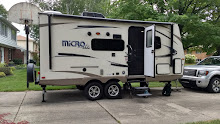Mon. June 10: Monday’s
track took us east and north to do the Mount Hood/Columbia River Gorge circle.
The route to Mount Hood was right outside the gate of the park so after toast
with peanut butter and a glass of milk, we were on our way. It was cloudy and
cool when we left and we feared we wouldn’t be able to see Mount Hood from a
distance nor anything from there. But the sun came out as the road climbed to
over 5000 feet and then we took the spur to Timberline Lodge at 6500 feet,
where there was still snow on the ground between the trees. Then we were in for
a very pleasant surprise. The historic lodge is the hub for a year-round ski
area. We parked the truck and, finding that they had an 11:30 Buffet Lunch we
decided to fill our time until then. We hiked partway up a trail that was
mostly gravel and clear of snow but lead to the bottom of the ski runs. High
above us we could see a chair lift running and tiny dots of skiers and
snowboarders beginning their descents at 8500ft. There are no trees at that
level—just the hard packed snow field. Further up, we could barely make out a
few hikers climbing to the summit. After a while we went into the Lodge and
watched a video about the building of the magnificent building. It was a WPA
project, which used Arts money so was built by craftsmen and used a gifted
female Interior Designer from Portland. Always administered by the Forest Service,
it was mismanaged and fell into disrepair in the fifties before being
resurrected and refurbished by a local businessman. Now it is a beautiful and
successful year-round facility. We found a ranger giving a tour of the building
so we added on to that and learned more about the Lodge, the most recent
eruption of Mount Hood about 220 years ago (just before Lewis and Clark
arrived), and the area before we had the wonderful lunch. Our window table
looked south to Mount Jefferson and The Three Sisters in the distance. The food
was local and delicious so we were stuffed by the time we left.
.JPG) |
| Mount Hood ahead! |
.JPG) |
| Coming closer... |
.JPG) |
| Timberline Lodge |
.JPG) |
| Tiny dots in a line are the ski lift supports |
.JPG) |
| Marv "on the slopes" |
.JPG) |
| Ranger explaining the Lodge's history |
.JPG) |
| Mount Hood from the north side |
The road
descended going north, giving us nice views of the other side of Mount Hood and Mount Adams in Washington, and took us to the Columbia River where we visited first
the Cascades Lock, which was built in 1896 and is now mostly underwater, the
Bonneville Lock, built in 1938 and no longer used, and then the Bonneville Lock
and Dam, built in 1993. There is a nice Visitors Center which explains both the
locks system and the hydroelectric capacity and has an underwater
viewing/counting station for one of three fish ladders to facilitate migrating
salmon and steelhead. I got a few more stamps for the Passport there, including
another Lewis and Clark stamp because they traveled the area and included the
Cascades in their Journals. The Cascades were caused by two mountains on the
Washington side that had such giant rock slides 350-700 years ago that they
actually dammed the river and caused a bridge across the Columbia that is
included in the oral history of the Chinook Indians, who called it the Bridge
of the Gods. Eventually the mighty river worked its way through the dam and
carried the rocks downriver forming the cascades or rapids for many miles.
.JPG) |
| Bonneville Locks and Dam |
.JPG) |
| Fish ladder beside the dam |
From
there we picked up the Historic Columbia River Highway. Old US 30 connects
Dobson and Corbett and from it one can view 5 different waterfalls cascading
over the walls of the Gorge. We stopped at each one and walked about 3 miles of
trails to see Horsetail Falls and Upper Horsetail (or Ponytail) Falls,
Multnomah Falls, Wahkeena Falls, Latourell Falls, Crown Point Vista House, and
Women’s Forum Overlook. Somehow we missed Bridal Veil Falls but we were
satisfied with what we had seen. We had almost come full circle and the GPS
told us how to complete the journey, taking us past 20 miles of orchards, berry
farms, and doggie spas and back to the campground. The spaghetti sauce we had
left in the mini-Crockpot was ready but we still weren't very hungry after our
big lunch. So we both took showers before we had salads and a small serving of
spaghetti, leaving enough for another dinner. It had been an even better day
than we had hoped for and the unexpected addition of Mount Hood to our plan was
a wonderful success.
.JPG) |
| Horsetail Falls |
.JPG) |
| Upper Horsetail (or Ponytail) Falls from behind |
.JPG) |
| Multnomah Falls |
.JPG) |
| Wahkeena Falls |
.JPG) |
| Latourell Falls |
.JPG) |
| Looking up river from the Vista House |
.JPG) |
| Looking down river from the Vista House |
.JPG) |
| Historic Columbia River Highway |
.JPG)
.JPG)
.JPG)
.JPG)
.JPG)
.JPG)
.JPG)
.JPG)
.JPG)
.JPG)
.JPG)
.JPG)
.JPG)
.JPG)
.JPG)
.JPG)
.JPG)
.JPG)
.JPG)
.JPG)
.JPG)
.JPG)
.JPG)
.JPG)
.JPG)
.JPG)
.JPG)
.JPG)
.JPG)
.JPG)
.JPG)
.JPG)
.JPG)
.JPG)
.JPG)
.JPG)
.JPG)
.JPG)
.JPG)
.JPG)
.JPG)
.JPG)
.JPG)
.JPG)
.JPG)
.JPG)
.JPG)
.JPG)
.JPG)
.JPG)
.JPG)
.JPG)
.JPG)
.JPG)
.JPG)
.JPG)
.JPG)
